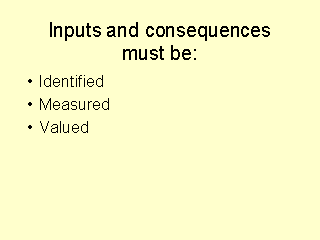|
|
|
|
front |1 |2 |3 |4 |5 |6 |7 |8 |9 |10 |11 |12 |13 |14 |15 |16 |17 |18 |19 |20 |21 |22 |review |
 |
All methods of economic evaluation value both inputs and consequences
following the same three-stop road:
- identify inputs and consequences; - measure inputs and consequences using appropriate physical units; - valuate inputs and consequences; Problems are encountered in all three phases. Some items are difficult to identify as some health care interventions have hidden or unknown costs and consequences. Not all costs and consequences can be measured in appropriate physical units as some interventions have intangible consequences such the reduction of pain or the increase of the quality of one's social performance. Other programmes use inputs which are equally difficult to quantify such as hi-tech know-how. Values of resources are assigned by defining costs. These are considered by economists to be the benefits of opportunities foregone, i.e. the best possible alternative use of the same resources (opportunity cost). Such a definition of cost carries several implications. Firstly, costs do not equate with expenditure, as all that can be used in an alternative manner is a cost, even though it appears freely available and there does not appear to be a market for (such as fresh air, or a voluntary worker's time). Secondly, values and hence costs vary according to value judgments and other factors (such as timespan) which depend on individuals, society, scarcity and need. Valuing inputs and consequences is the most difficult aspect of conducting an economic evaluation as in reality the only readily available measures of value, prices, exist only where there are true markets, and these cover only a minority of health inputs and consequences. |